Discover fun family games around the theme of colours:

Game – The little colour bin!
What if we reinvented the famous game of the little tub where players have to find words starting with a given letter like A as quickly as possible… Andy Warhol as a personality, Argentina as a country, Apricot as a fruit, etc.?
Game | Several players | Family or friends
Materials: Paper and pen
Instructions: Make up your own chart by choosing from the following examples:
Who is the colour :
- Object
- Food
- Dish
- Dessert
- Brand
- Animal
- Artwork
- Flag
Which evokes colour for you :
- Emotion
- Memory
- Person
- Quality / defect
Whose name the colour is part of:
- Film title
- Music title
- Expression
In the traditional manner of the small bin, the players agree on a colour and each of them completes a line by filling in the different categories. The first to finish stops the round. Take time to discuss and comment on each other’s answers and keep score! 2 points for original words, 1 point if several players have found the same word and 0 for empty spaces.

Discover this theme in the exhibition Colors, etc. :
Not gathered around a small tub but at the Domaine de Boisbuchet, in Lessac, fifteen people from all over the world responded to the call from the Austrian studio mischer’traxler to experiment with the relationship between colour and human perception. They associated each primary and secondary colour (red, blue, yellow, orange, violet and green) with qualifiers – such as “aggressive” or “spiritual” – and then translated them into a movement – such as “fast” or “swinging” – to finally create a scenario around the execution of this movement that relates to a given colour.
Visual : mischer’traxler © lille3000

Game – Create your own colour lexicon!
Burnt orange, lapis lazuli, verdigris… what funny names, right? Each colour has a history and a name associated with it, but perhaps you could assign new ones to them… it’s up to you!
Games | Alone or with others | From 6 to 90 years
Material: A cocktail of anecdotes, stories and a good dose of imagination with a touch of madness.
Instructions:
In groups: take turns telling a memory, a joke or a particular moment linked to a colour in order to create a collective colour lexicon. An opportunity to share a colourful moment!
Variation: you can reverse the game and have the group guess a colour by telling what it reminds you of or what it evokes in you. Perhaps yellow takes you back to a beach with warm, sparkling sand, or orange evokes the flavours of a spicy dish shared with your friends, or blue evokes a shiver associated with the feeling of cold that comes over you when your foot sticks out of the duvet on icy winter nights…
On your own: you can just as easily create your own personal colour lexicon. Associate each colour with a memory, a story, a smell, an object… You can keep all these treasures in a notebook or a box to retrace your history in colour.
Feel free to share your experience with us #lille3000 #colorsetc #youngcolors #tripostal
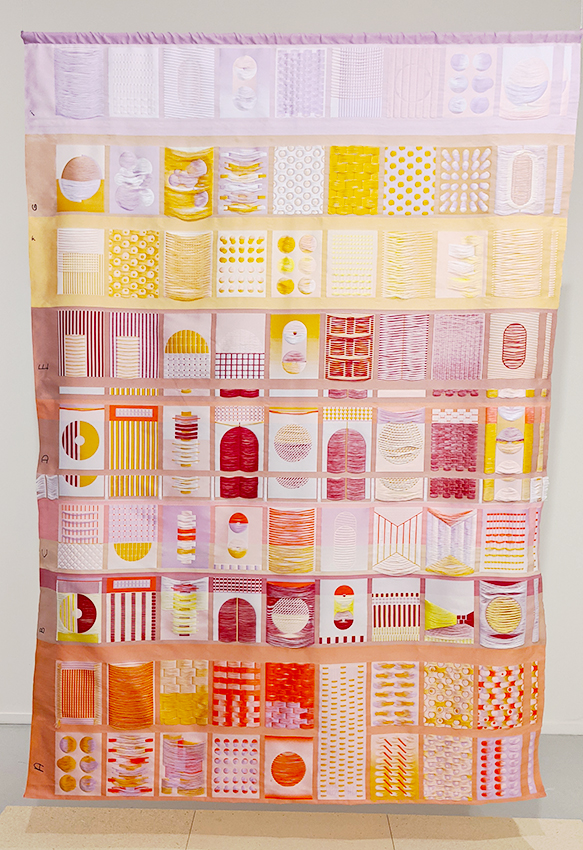
Discover this theme in the exhibition Colors, etc. :
Artist Navine G. Khan-Dossos also looked at the effect colours can have on our emotions by holding workshops with patients at St Mary’s Hospital in Paddington, England. Together they composed a colour palette designed to improve the hospital environment and gave each shade a new name such as London sky, Drumpf orange or Netflix red.
Visual : Navine G. Khan-Dossos © lille3000

DIY workshop – Dyeing with natural pigments!
A faded sheet, a never-worn T-shirt or socks that have lost their half? Take the opportunity to try natural dyeing from food. You don’t have to buy anything, just salvage and divert what you already have at home and combine cooking and textiles!
Activity | Alone or with others | From 3-4 years old, accompanied by an adult | About 2 hours
Materials :
- Saucepan
- Wooden spoon
For the pigments, choose according to your desires or what you have in your kitchen:
- Washed and dried avocado peel
- Onion peel
- Red cabbage
- Carrot tops
- Various spices: turmeric, curry, saffron, paprika
- Tea
…
Condition: not all fabrics can be dyed with vegetable dye, natural fibres must be used: cotton, linen, hemp, silk, natural wool.
Instructions: the weight of fabric to be dyed must correspond to the weight of dye (for example for 50g of fabric you must have 50g of cabbage).
- Fill a pan with ¾ of the plant material, add water and boil for about 30 minutes.
- Dip the fabric into the dye and heat over medium heat for about 1 hour, stirring regularly to obtain a homogeneous colour.
Tip: you can also have fun folding and tying your fabric with rubber bands to get a nice effect.
- Rinse the fabric in a vinegar and water bath to fix the colour.
- Once dry, the fabric is ready!
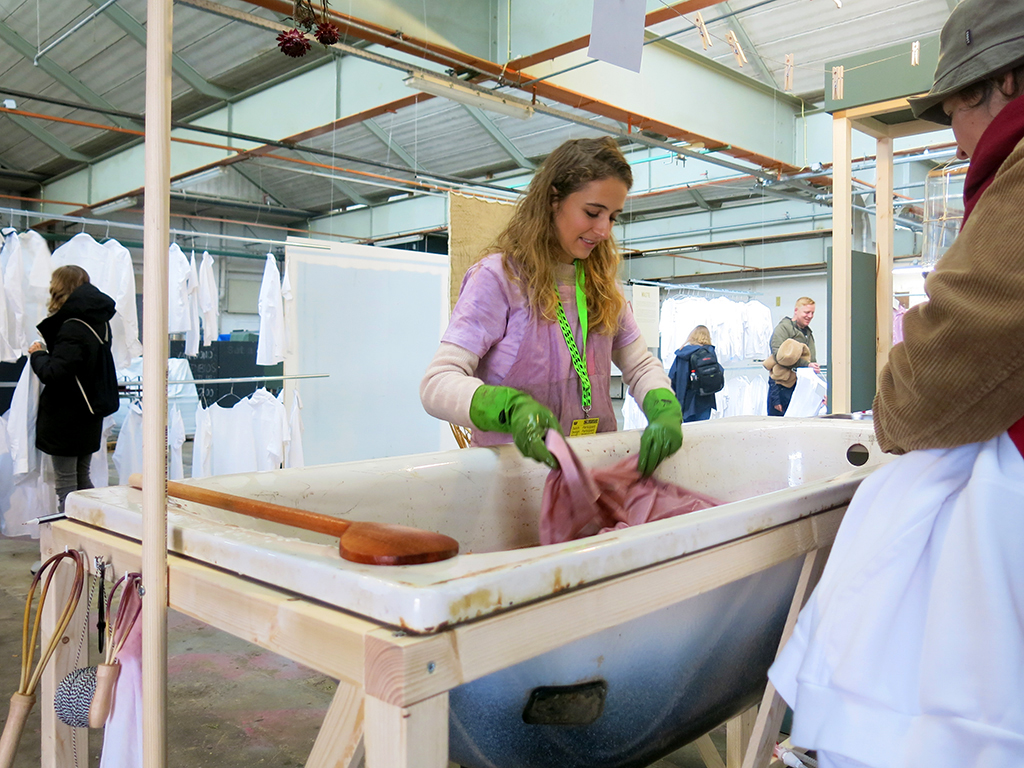
Discover this theme in the exhibition Colors, etc. :
This workshop is about Nienke Hoogvliet’s approach. After learning that many textiles contain harmful chemicals from the industrial production process, she wondered whether it would be possible to offer beneficial effects to our skin and body by using plant-based dyes.
Fore more information : https://www.nienkehoogvliet.nl/portfolio/h-e-r-b-s-installation/
Visual : Nienke Hoogvliet © Bas Gijselhart

DIY workshop – Create your own natural colour palette!
Collect, sort, compose and preserve! Become a gardener, a cook, a scientist, an artist and a collector all at the same time with this workshop that starts as a treasure hunt, is lived as an experiment and calls for the curiosity and creativity of your children!
Activity | Alone or with others | Children from 3 years old accompanied by an adult
Materials :
- All natural elements that you can find
- Saucepan
- Mortar and pestle
- Apron or clothing that can be stained
Instructions:
- The first step is to collect!
The natural colours that surround us, whether they come from the plant, mineral or food world, can offer a very rich palette!
In the garden: flowers, earth, charcoal sand or walnut stain…
In the kitchen: fruits and vegetables such as beetroot, aubergine, onion, artichoke, blackberry, cherry, plum, prune, spices (saffron, curry, turmeric, paprika…)
- The second step is to extract the colour!
Elements that can be used directly: beetroot, charcoal, earth…
By grinding: most plants (parsley, poppy, etc.). For red cabbage, grated raw beetroot or grated carrots, for example, mix them with a little water to purée them and then press them in a cloth to extract the juice.
With cooking: some flowers should be cooked in a little water to be puréed to obtain coloured juice; this is the case with geranium petals, which give reddish-purple tones, or broom petals. Onion peels cooked in water will give you a light yellow-brown colour.
By dilution: spices, coffee, tea.
Tip: coffee, tea, spices and earth can also be glued directly onto the child’s artistic composition to create volume!
- And finally, experiment and create!
Once the child’s palette has been created and the different colours obtained, it’s time to be creative! Let them experiment with the effects produced and express themselves in the production of their choice (painting, research notebook/diary, etc.). A painting composition can be completed with elements in felt-tip pens, pencils, etc.
Tip: when the drawings are finished, the children can even sprinkle them with salt, or pour a few drops of white vinegar or lemon… the paintings are transformed!
Caution: Make sure that the children do not ingest some of the juices obtained, which could be toxic depending on the flowers used. Translated with www.DeepL.com/Translator (free version)
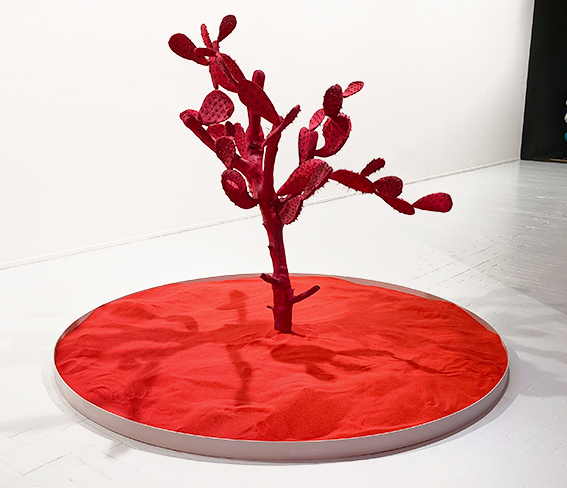
Discover this theme in the exhibition Colors, etc. :
You are not the first to experiment with colour using what nature offers us… For example, Fernando Laposse is interested in the small insect, the cochineal, to obtain the carmine red colour that he uses to dye his works. Atelier NL has developed a colour chart of 270 colours made using the traditional technique of extracting colour directly from the earth.
Visual : Fernando Laposse © lille3000

DIY workshop – Recipe for edible paint!
An original idea to lead a painting workshop without risk for the child who will surely find this activity to his taste! It’s easy to make edible paint with what we have in our cupboards!
Activity | Alone or with others | Children from 3 years old accompanied by an adult | Approximately 15 minutes of preparation
Materials :
- 2 cups of flour
- 2 cups of water
- ½ cup of salt
- ¼ cup sugar
- natural colouring
- 1 bowl
- thermal pots
Recipe:
- Mix the dry ingredients in a bowl: flour, salt and sugar
- Slowly add the water while mixing
- Pour the mixture into as many different coloured containers as you like
- Add the natural colouring*.
- All you have to do is protect your floor and you’re done!
Conservation: can be kept for about ten days if the paint is well preserved.
*For natural colouring you can use: beetroot juice (for pink), turmeric, saffron or curry (for yellow), carrot juice or paprika (for orange), cocoa powder (for brown), spinach leaf juice (for green), red fruit juice (for red), rice powder (for white), etc.
Did you know? There is no natural red dye in nature. The only natural dye is obtained by grinding insects, such as the cochineal for carmine red.
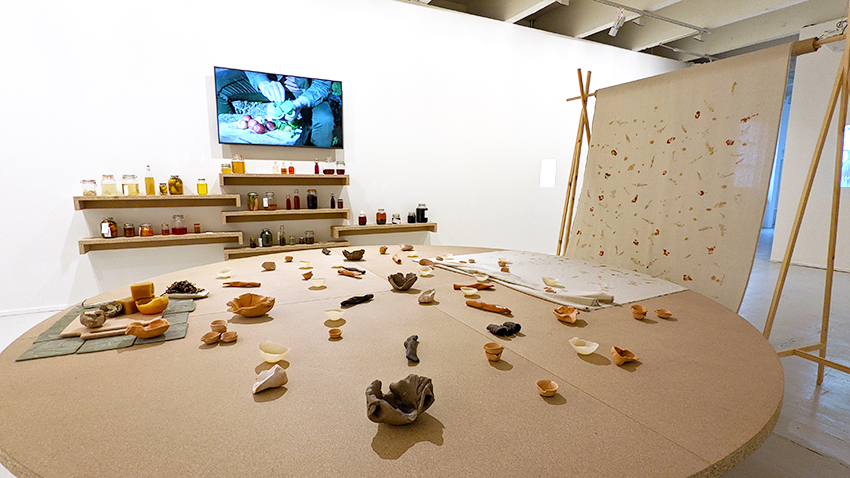
Discover this theme in the exhibition Colors, etc.
The French artist Céline Pelcé also likes to create with food, as she has been incorporating food into her art installations and performances since 2012. Her works degrade over time and are produced and designed with elements from the environment around us.
Visual : Tabulatopia © lille3000

Experience – A rainbow in your living room!
Red, orange, yellow, green, blue, indigo and violet, got it ? Yes, these are the colours that make up a rainbow! But why wait for it to appear in the sky to contemplate it, when there’s nothing easier than creating your own?
Activity | Alone or with others | From 3-4 years old, accompanied by an adult | About 2 hours
Materials :
– a bowl / basin
– a small mirror
– a blank sheet of paper
– a light source (torch, spotlight, etc.)
– water
Instructions:
– Fill your bowl / basin half full
– Place the mirror on top, tilting it slightly but not submerging it completely
– Point the light source towards the mirror, on the surface of the water, and place a white sheet of paper on the reflection
– All you have to do is observe the rainbow that forms!
Tip: If you do not see it appear, move the tilt of the torch.
Did you know ? The rainbow is formed by refraction. It is a deflection of light when it changes medium, but white light is made up of all colours and each one is deflected at a different angle ! The result is the separation of all the colours and the formation of a rainbow.

Activity – Design your space with giant puzzles!
Do you need a new look without leaving your home? We suggest you take over the space around you by forming monochrome compositions. Like a giant jigsaw puzzle, accumulate objects of identical (or similar) colours to create strange constructions!
Activity | Alone or with others | Children from 3 years old
Materials :
- Anything you can find around you
Instructions:
- Open your eyes wide and look for as many objects of the same colour or shade as possible.
For white you might find: candles, cushions, boxes of all sizes, dishes…
- Be clever and find out how to assemble and fit these objects to furnish a corner, create a wall or build a sculpture of your choice.
- You can have fun deconstructing and reconstructing as many times as you like!
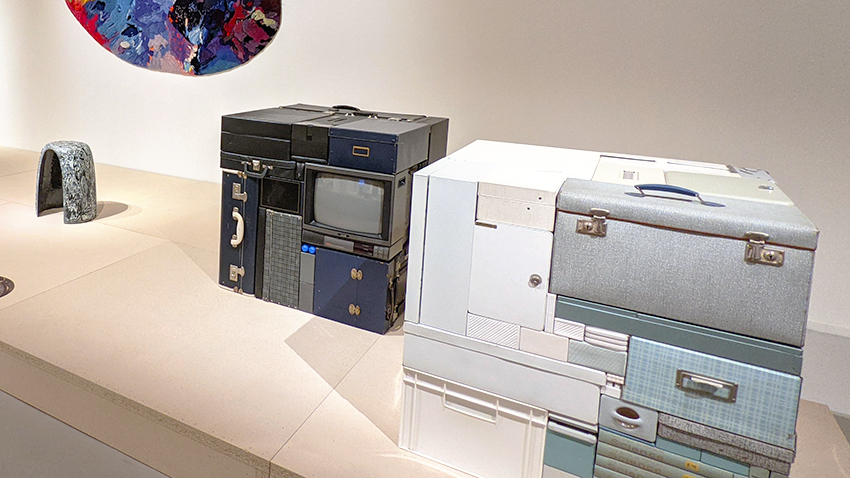
Discover this theme in the exhibition Colors, etc. :
This construction game was inspired by Michael Johansson. This Swedish artist makes ordinary objects fit together to transform them into perfect geometric shapes. He collects objects such as suitcases, household appliances, cardboard boxes, etc., sorts them by colour and assembles them like a puzzle to create a unique whole!
Visual : Michael Johansson © lille3000





